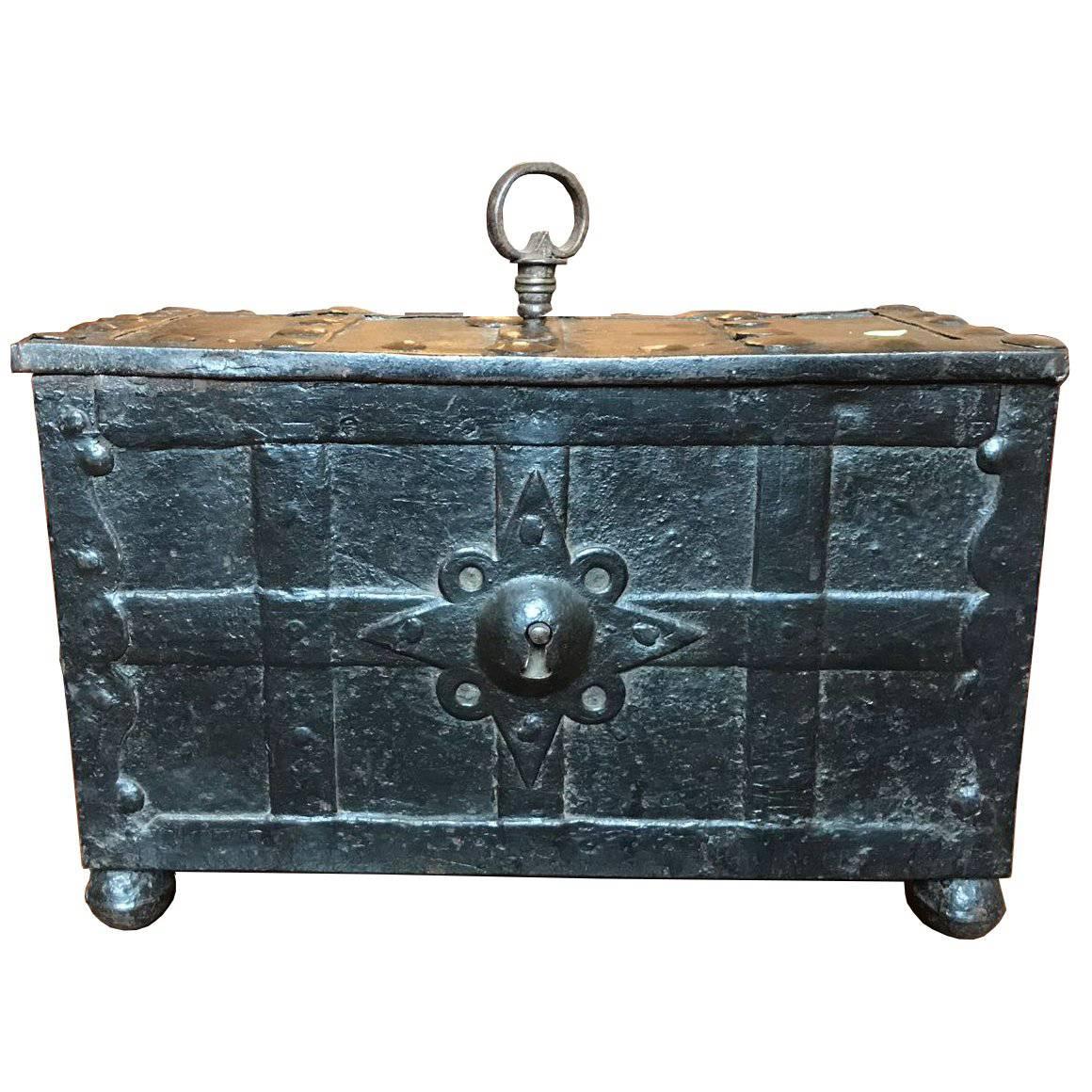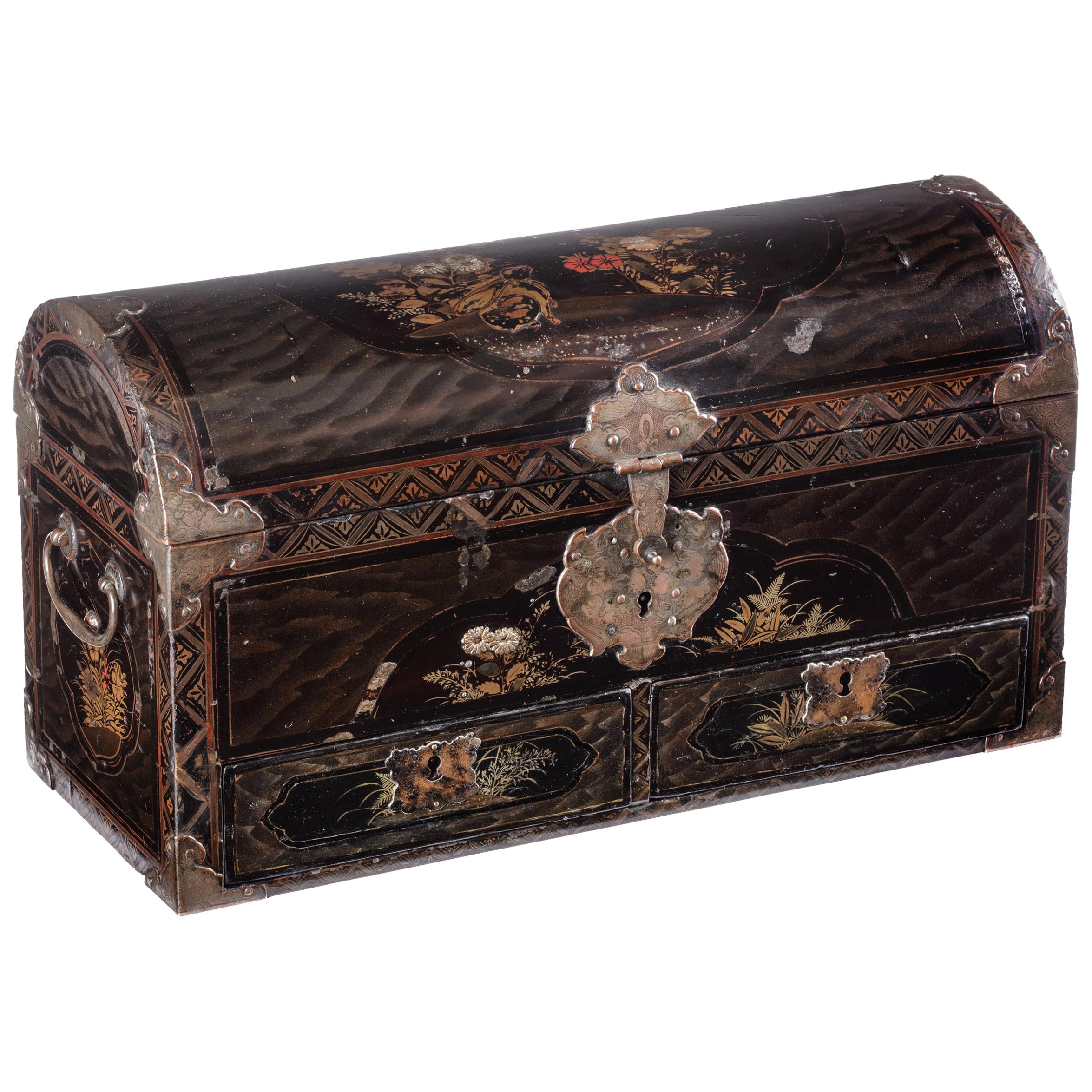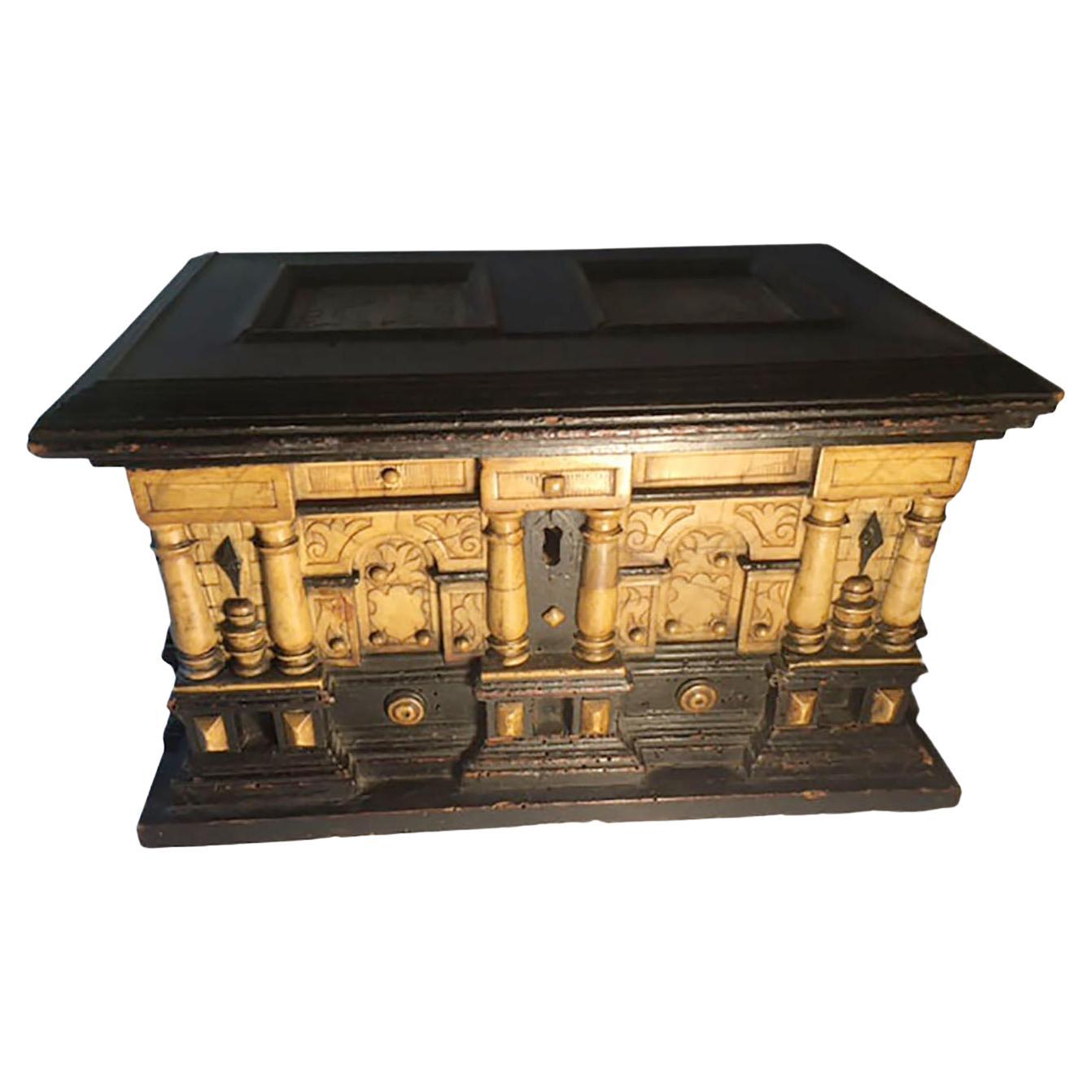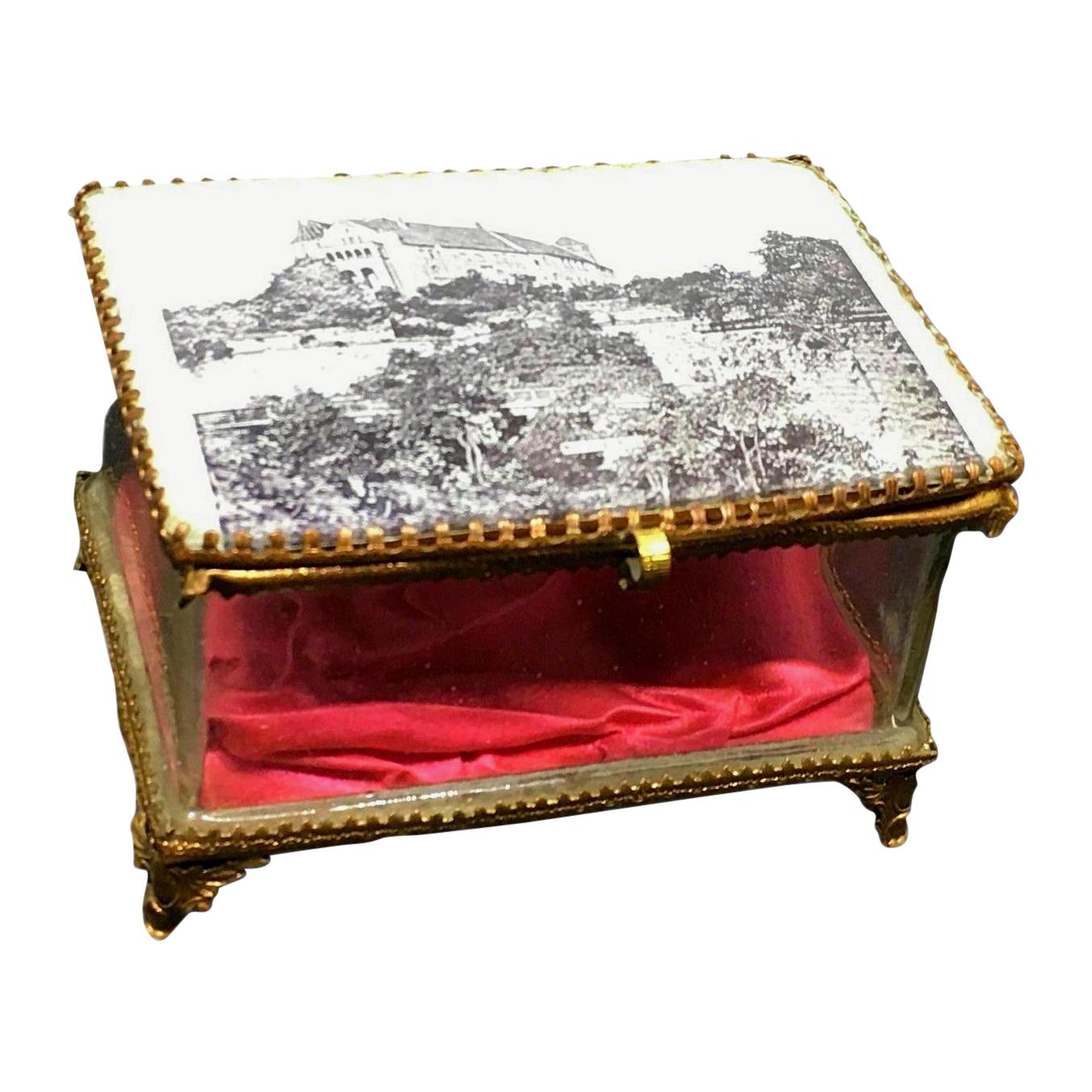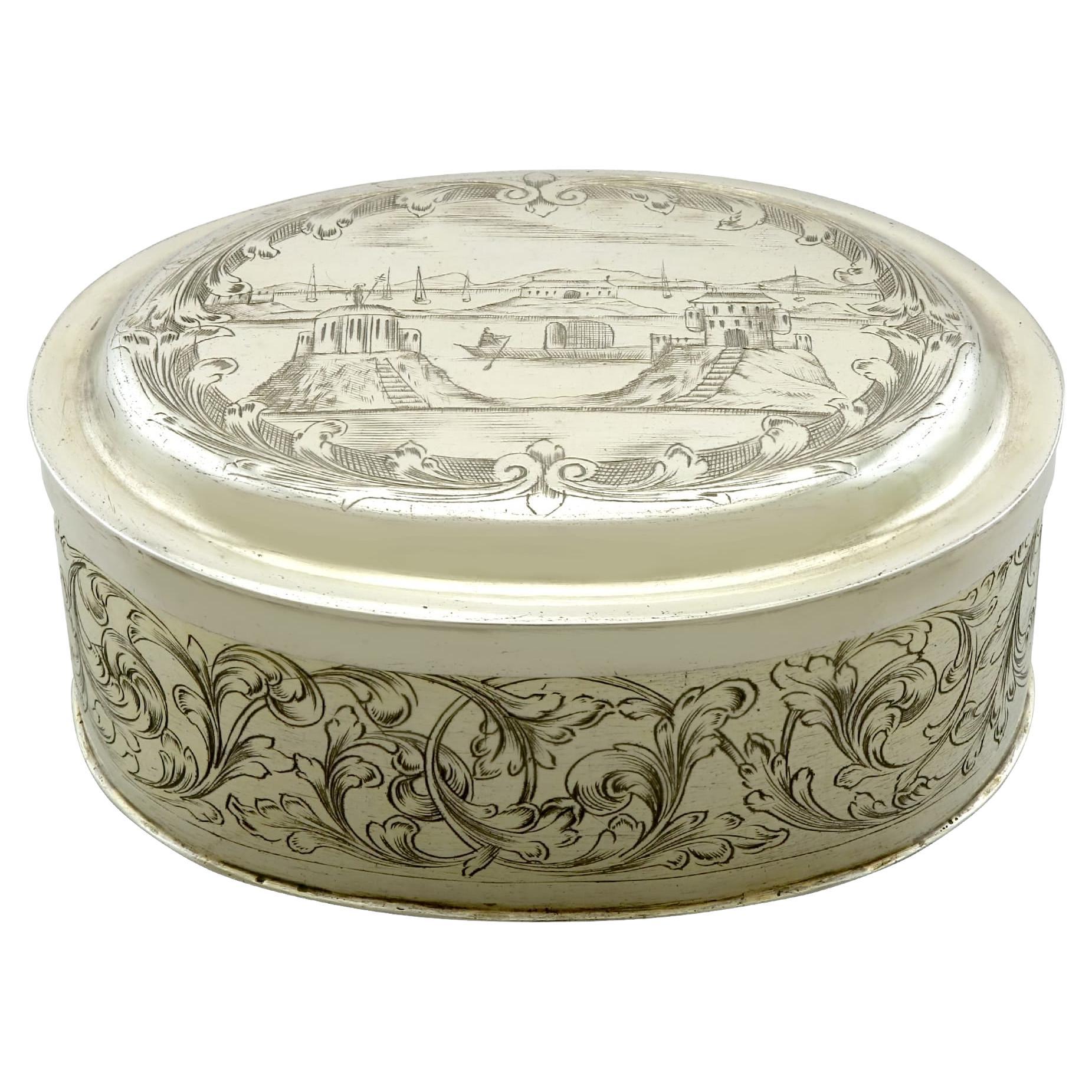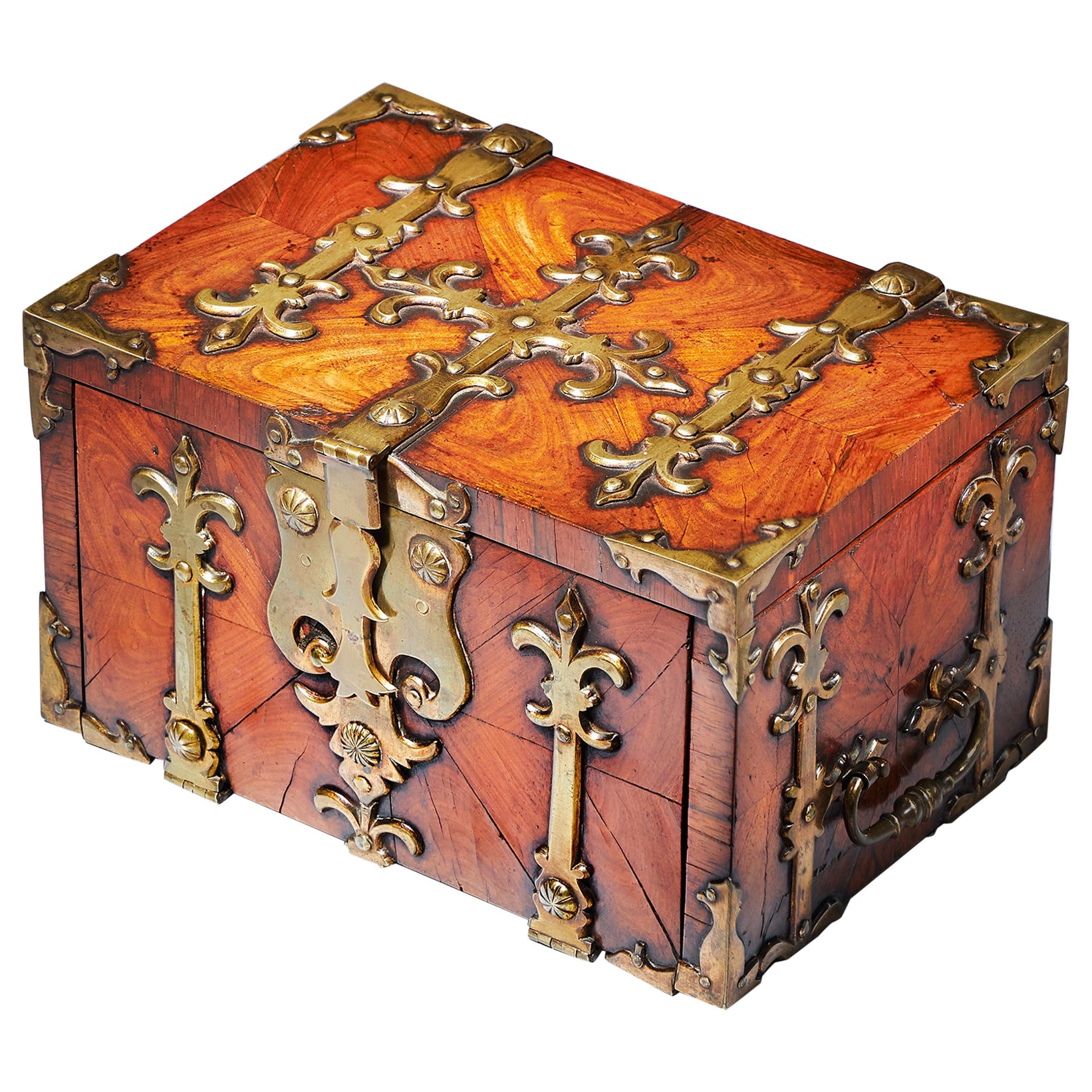Items Similar to 17th Century Nuremberg, German Iron Strongbox Jewels Casket
Want more images or videos?
Request additional images or videos from the seller
1 of 15
17th Century Nuremberg, German Iron Strongbox Jewels Casket
About the Item
Ornately painted cash box with iron hardware and key, on the original stand. Interior of box measures 8"W x 4"H x 3.75"D
Exceptional, small, late-renaissance, table-top, Nuremberg, iron, 'Wedding Box', strongbox or travelling safe with its original, naïve, painted decoration
This is a rare and small example of these characterful, early models of transportable safes. The much larger traditional chest sized strongboxes are more common, not many small strongboxes like this one survive, because less were made and they were broken into and destroyed. As well as gold and jewelry, documents were kept in strong boxes. The original keyplate is intact, as is the lock mechanism which is in working order (except for the right side lock needs repair and a rod replaced) this strongbox can still perform and lock on the left side mechanism.
The top has two panels reinforced with strap work, and bolts and retaining traces of their original stylized paintings of flowers and foliage. The central rotating key plate reveals the keyhole. The key operating the original locking mechanism on the interior of the lid throwing one bolt (one is missing parts and is broken). Protected by a inner lock plate in a Bat motif and Acanthus leaves painted on the edge.
The front with four, panels reinforced with strap work and bolts. The panels are painted with stylized chrysanthemums. The sides with one panel reinforced with strap work and bolts and a repeat of the decoration on the front. Original carrying handles. Nuremberg, Southern Germany, circa 1600.
- Dimensions:Height: 6 in (15.24 cm)Width: 9 in (22.86 cm)Depth: 4.75 in (12.07 cm)
- Style:Jacobean (Of the Period)
- Materials and Techniques:
- Place of Origin:
- Period:
- Date of Manufacture:17th Century
- Condition:Wear consistent with age and use. Minor losses. Minor structural damages. Minor fading. Interior of locking mechanism is missing pieces and one part is broken. Key can still be inserted and turned.
- Seller Location:Soquel, CA
- Reference Number:
About the Seller
5.0
Gold Seller
These expertly vetted sellers are highly rated and consistently exceed customer expectations.
Established in 1986
1stDibs seller since 2015
166 sales on 1stDibs
Typical response time: <1 hour
- ShippingRetrieving quote...Ships From: Soquel, CA
- Return PolicyA return for this item may be initiated within 14 days of delivery.
More From This SellerView All
- Agate and Ormolu Jewel box French Made 20th CenturyLocated in Soquel, CAAgate and ormolu French jewel box, the casket form in variegated red, black and pink stone, with hinged lid opening to a velvet lined interior, together ...Category
20th Century French Jewelry Boxes
MaterialsAgate, Gold Plate
- Bronze Jewelry-Casket with Ornate Etchings and Cameos Inlaid by Tahan of ParisBy Tahan ParisLocated in Soquel, CABronze Jewelry-Casket with Ornate Etchings and Cameos Inlaid by Tahan of Paris Gorgeously detailed jewelry box by Tahan of Paris. There are four Cameos bezel set on three sides of t...Category
Antique Late 19th Century French Louis XV Jewelry Boxes
MaterialsBronze
- Early 20th Century Cast Brass & Iron Sheffield NY Baroque Style AndironsBy Sheffield Mfg. Co 1Located in Soquel, CAEarly 20th Century Cast Brass & Iron Sheffield NY Baroque Style Andirons Ornately detailed, Baroque style heavy duty cast brass and iron fireplace andirons by Sheffield NY (American...Category
Early 20th Century North American Baroque Andirons
MaterialsBrass, Iron
- Mid Century Hertel Jacob German Porcelain Ginger Jar, Signed Fuchs-NadlerLocated in Soquel, CAA lovely mid-century Bavarian porcelain ginger jar with gold trim and gilt details by Hertel-Jacob Porzellan (German, 1906-1979). This large ginger jar is ornately decorated with a highly detailed romantic figurative landscape scene, in which three men depicted in gold enjoy an opulent picnic of wine, meat, and fruit under a tree, in front of a large medieval castle complete with a canon and canon balls. A gold leaf motif decorates the backside of the piece. The signature "Fuchs-Nadler" can be found within the picnic scene, underneath the tray of food and wine. Stamped on bottom with mark "Hertel-Jacob Porzelan / Bavaria Germany", and the serial number 1266. Measures 14"H x 7"D. **Please note: The top of the lid has been re-attached and a hairline crack in the gold is visible (see photos). Hertel-Jacob Porzelan History: Porzellfabrik Jacob, Schödl & Co. (1906 until 1912) The factory was founded in 1906 by the industrial Jacob together with his financial partner Schödl and its product range during the first years included giftware items, vases, storage canisters...Category
Mid-20th Century German Biedermeier Jars
MaterialsGold Plate
- 19th Century Wine Server American Renaissance RevivalBy Herter BrothersLocated in Soquel, CAHerter brothers era and style wine server in mahogany and walnut. Carved grape and leaf motif. Carved shelf side garnishment trim (One missing). Circa 1878-1898. Original finish. Bre...Category
Antique Late 19th Century American Aesthetic Movement Shelves
MaterialsMahogany, Walnut
- 19th Century Limoges French Painted Porcelain PitcherBy Delinieres & Co. 1Located in Soquel, CA19th Century Limoges French Painted Porcelain Pitcher Rare and prized, American Amateur painting on French Limoges pitcher, circa 1897. Dimensions, 1...Category
Antique 19th Century French Aesthetic Movement Vases
MaterialsPorcelain, Paint
You May Also Like
- Early 17th Century Medieval Handcrafted Black Iron German CofferLocated in Brescia, ITThe iron coffer, fully original in every part of it, was forged and handcrafted in German in the 1610. Complete with key. Full working iron mechanisms. It ...Category
Antique Early 17th Century German Medieval Decorative Boxes
MaterialsIron
- Fine Japanese Namban Lacquer Jewelry Casket, 17th CenturyLocated in Amsterdam, NLJapanese Namban lacquer transition-style coffer with two drawers Kyoto/Nagasaki, circa 1650 The cartouches with gilt and red decorations of leaves...Category
Antique 17th Century Japanese Edo Lacquer
MaterialsCypress
- 17th Century, Alabaster and Ebonised Wood Casket Malines CofferLocated in Dallas, TXA 17th century Malines alabaster and ebonised wood coffer or casket with engraved inset panels, arches and columns. The interior has a marbled paper lini...Category
Antique 17th Century Belgian Decorative Boxes
MaterialsAlabaster
- Antique German Casket Trinket Box Ormolu Glass Satin Nuremberg Souvenir, 1890sLocated in Nuernberg, DEA gorgeous glass trinket box with some ormolu adornments. The hinged top featuring a City view of the Nuremberg Castle. No restoration has been carried out on this charming little tr...Category
Antique Early 1900s German Hollywood Regency Jewelry Boxes
MaterialsOrmolu
- 17th Century German Silver Gilt Tobacco BoxBy Johann Christoph Treffler 1Located in Jesmond, Newcastle Upon TyneAn exceptional, fine and impressive antique German silver gilt tobacco box; an addition to our 17th century silverware collection. This exceptional antique 17th century German silver...Category
Antique 1690s German Snuff Boxes and Tobacco Boxes
MaterialsSilver
- 17th C. Diminutive William and Mary Kingwood Strongbox or Coffre Fort, C. 1690Located in Oxfordshire, United KingdomA William and Mary Kingwood / Princes Oyster Strongbox or Coffre Fort of Diminutive Proportions, Circa 1680-1700, England. Adorned with highly decorative gilt brass strapwork and decorated entirely in knife cut oysters of kingwood, this box is fit for the most discerning of collectors. The large gilt brass shield-shaped clasp opens on a push-spring release to reveal a box interior lined in rosewood with one drawer and securing bolts. Once the lid is opened you can reach inside to slide the original gilt brass bolt lock to open the fall. Once the fall is open you will find a drawer lined in oak and simulated kingwood. The box appears decorative, but it was also very difficult to break open or steal. It has a strong lock to the centre and two bolts concealed in the sides, so that it could be screwed down into floorboards if necessary or that of a horse-drawn carriage. Strong boxes veneered in oysters of Princewood such as this were luxury objects. The cabinet-makers who would have constructed and veneered the carcase apparently sold them, often using tropical hardwood veneers, and mounted it with sets of mounts, handles and locks bought in from brass founders. The elaborate veneering and conspicuous gilded brass mounts show that the appearance of these objects was important. Thomas Pistor, of Ludgate Hill, London worked with the renowned cabinetmaker Gerrit Jensen...Category
Antique 17th Century British William and Mary Decorative Boxes
MaterialsKingwood
